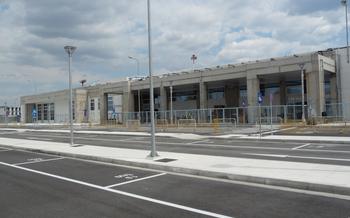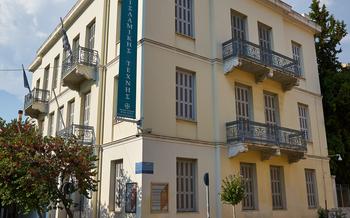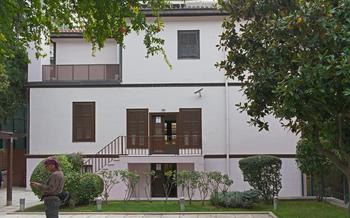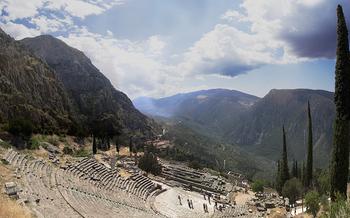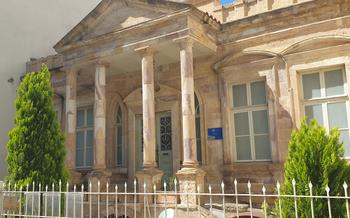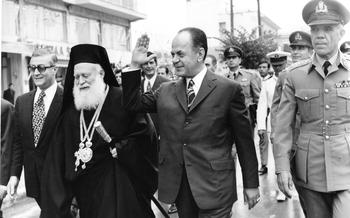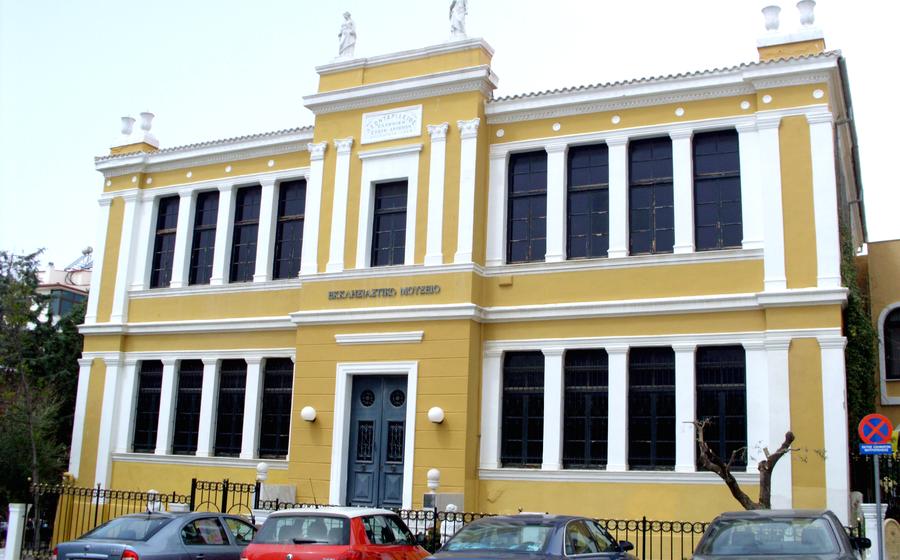
Museum of Islamic Art in Didymoteicho
- A Journey Through Time: Exploring the Museum of Islamic Art in Didymoteicho
- Delving into History: The Story of Didymoteicho
- Exploring the Museum's Treasures: A Visual Delight
- Unveiling the Islamic World's Rich Heritage
- A Walk Through Islamic History: The Museum's Galleries
- Beyond the Museum Walls: Discover Didymoteicho's Charm
- Practical Information for Visitors: Planning Your Trip
- Insider Tips for Enhancing Your Experience
- Unveiling the History of Islamic Art in Greece
- Exploring the Museum's Collection Highlights
- The Museum as a Center for Research and Scholarship
- The Museum's Contribution to Tourism and Cultural Tourism
- The Museum's Architectural Significance
- Insider Tip: Capturing the Perfect Photo
A Journey Through Time: Exploring the Museum of Islamic Art in Didymoteicho
Nestled in the heart of Didymoteicho, a city brimming with historical charm, the Museum of Islamic Art stands as a testament to the region's rich cultural heritage. Immerse yourself in a journey through time as you explore this captivating museum, where Islamic art and history intertwine to create a mesmerizing tapestry of cultural influences. Admire the stunning architecture that seamlessly blends Islamic and Byzantine elements, a reflection of the diverse cultures that have shaped this vibrant city. Delve into the museum's treasure trove of Islamic art, from exquisite ceramics and intricate textiles to beautifully illuminated manuscripts, each piece narrating a chapter in the story of Islamic civilization.
Delving into History: The Story of Didymoteicho
Didymoteicho's rich history can be traced back to antiquity, when it was known as "Plotinoupolis" and served as a strategic location along the Evros River. During the Byzantine period, the city flourished as a fortified settlement, becoming an important administrative and cultural center. Its strategic location made it a frequent target for invasions, resulting in a blend of Byzantine and Ottoman influences that shaped its architectural and cultural heritage.
In the 14th century, Didymoteicho became the capital of the Ottoman province of Rumeli, ushering in a period of significant development and prosperity. The city's population swelled with the influx of Turkish settlers, and its architectural landscape transformed, with the construction of mosques, madrasas, and other Ottoman-style buildings. Didymoteicho's strategic importance continued throughout the Ottoman period, as it served as a key military and administrative center.
After the Balkan Wars and the Treaty of Lausanne in 1923, Didymoteicho became part of modern Greece. The city underwent a significant transformation, as many of its Muslim inhabitants left and were replaced by Greek refugees from Asia Minor. This exchange of populations left an indelible mark on Didymoteicho's cultural and demographic makeup, contributing to its unique blend of Greek and Turkish traditions. Today, Didymoteicho stands as a vibrant modern city, proudly preserving its rich historical legacy while embracing the opportunities of the 21st century.
Exploring the Museum's Treasures: A Visual Delight
The Museum of Islamic Art in Didymoteicho houses an awe-inspiring collection of Islamic art that spans centuries and diverse cultural influences. Among the highlights are the exquisite ceramic pieces, renowned for their intricate designs and vibrant colors. From delicate pottery to grand architectural tiles, each ceramic masterpiece tells a story of craftsmanship and artistic brilliance.
The museum's textile collection is equally captivating, showcasing the intricate embroidery, weaving, and printing techniques that were integral to Islamic art. From finely woven carpets to richly embroidered garments, these textiles offer a glimpse into the everyday life and cultural traditions of the region.
Calligraphy and manuscripts hold a special place in Islamic art, and the museum boasts a significant collection of illuminated manuscripts and calligraphic works. The intricate script and decorative motifs adorning these manuscripts showcase the artistry and precision of Islamic calligraphers.
Completing the museum's collection are stunning examples of metalwork and jewelry. From intricately crafted jewelry pieces to finely engraved metal objects, these artifacts showcase the exceptional craftsmanship and artistic vision of Islamic artisans.
Unveiling the Islamic World's Rich Heritage
The Museum of Islamic Art in Didymoteicho provides a fascinating glimpse into the diverse and vibrant artistic traditions that flourished in the Islamic world. From calligraphy to miniature painting and decorative arts, the museum showcases a wide range of mediums and techniques that convey the rich cultural heritage of Islamic civilization.
Islamic Art Forms
Islamic art encompasses a diverse array of artistic forms, each with its own unique characteristics and symbolism. Calligraphy, the art of beautiful writing, holds a central place in Islamic culture, with intricate scripts adorning manuscripts, architecture, and everyday objects. Miniature painting, with its vibrant colors and intricate details, captures scenes from history, mythology, and everyday life. Decorative arts, such as ceramics, textiles, and metalwork, showcase the exceptional craftsmanship and artistic flair of Islamic artisans.
Cultural Exchange
Islamic art played a crucial role in facilitating cultural exchange and fostering interfaith dialogue. As the Islamic world expanded, it came into contact with a variety of cultures and civilizations, leading to a vibrant exchange of ideas, techniques, and artistic influences. Islamic art absorbed elements from Byzantine, Persian, and Central Asian traditions, while also influencing the art of Europe and beyond. This cross-cultural pollination contributed to the development of a rich and diverse artistic tapestry that transcended national and religious boundaries.
Symbolism and Meaning
Islamic art is often imbued with deep symbolism and hidden meanings. Geometric patterns and motifs carry mathematical and cosmological significance, while calligraphy conveys religious verses and philosophical concepts. The use of color and light also holds symbolic value, with certain hues representing specific emotions or attributes. By deciphering these symbols and meanings, visitors gain a deeper understanding of the cultural and religious beliefs that shaped Islamic art.
Artistic Legacy
The artistic legacy of the Islamic world continues to exert a profound influence on contemporary art and design practices worldwide. From architecture to fashion, graphic design to music, Islamic art's motifs, patterns, and techniques have been reinterpreted and incorporated into a variety of creative expressions. The enduring appeal of Islamic art lies in its ability to transcend time and place, speaking to the universal human experience of beauty, spirituality, and cultural diversity.
A Walk Through Islamic History: The Museum's Galleries
The Museum of Islamic Art in Didymoteicho offers visitors a journey through time, showcasing the evolution of Islamic art through its chronologically arranged galleries. Each gallery presents a diverse range of artifacts, providing a comprehensive overview of the artistic achievements of the Islamic world.
Navigating the galleries, visitors can explore the early Islamic period, characterized by the emergence of a distinctive artistic style that blended Byzantine and Sassanian influences. This period witnessed the development of intricate ceramic designs and the use of calligraphy as an art form.
Further along, the galleries showcase the Umayyad and Abbasid dynasties, renowned for their grand architectural projects and the flourishing of Islamic decorative arts. Visitors can admire exquisite lusterware ceramics, finely woven textiles, and intricately carved metalwork from this era.
The Fatimid and Mamluk dynasties, with their centers in Egypt and Syria, are represented by a rich collection of illuminated manuscripts, textiles adorned with intricate embroidery, and mesmerizing carved ivory objects.
The Ottoman Empire, which ruled over the region for centuries, left an indelible mark on the museum's collection. Here, visitors can find elaborate Ottoman ceramics, finely crafted jewelry, and sumptuous textiles that reflect the grandeur of the imperial court.
Throughout the galleries, interactive elements and multimedia presentations bring Islamic art to life. Visitors can engage with virtual reality tours, touchscreens with detailed information, and hands-on activities that provide a deeper understanding of the artworks and their historical context.
Guided tours led by knowledgeable docents are also available, offering insights into the museum's collection and the significance of Islamic art in the region. These tours provide an immersive and enriching experience, allowing visitors to fully appreciate the treasures housed within the Museum of Islamic Art in Didymoteicho.
Beyond the Museum Walls: Discover Didymoteicho's Charm
Strolling through the picturesque streets of Didymoteicho's old town is like stepping back in time. Traditional houses with overhanging balconies, stone-paved alleys, and historic landmarks create an enchanting atmosphere that invites exploration. Discover hidden gems, such as small craft shops and cozy cafes, as you wander through this charming neighborhood.
Climb to the top of the Byzantine castle, a testament to the city's rich history, and be rewarded with panoramic views of the city and the surrounding countryside. The castle's ruins offer a glimpse into Didymoteicho's past as a fortified city that played a strategic role in the region's defense.
Didymoteicho's culinary scene is not to be missed. Indulge in traditional Greek cuisine at local tavernas, where you can savor delicious dishes prepared with fresh, local ingredients. Accompany your meal with a glass of wine from the region's renowned vineyards, known for producing some of the finest wines in Greece.
Throughout the year, Didymoteicho comes alive with cultural festivals and events that showcase the region's rich heritage and vibrant traditions. Experience the infectious energy of these celebrations, where locals and visitors alike gather to enjoy music, dance, and traditional performances. Don't miss the opportunity to immerse yourself in the city's lively atmosphere and connect with its warm and welcoming people.
Practical Information for Visitors: Planning Your Trip
Location and Accessibility: The Museum of Islamic Art is conveniently located in the heart of Didymoteicho, a charming town in northeastern Greece. The museum's exact address is: 11A Vasilissis Olgas Street, Didymoteicho, Greece. To reach Didymoteicho, visitors can take a bus or train from major cities like Athens, Thessaloniki, or Alexandroupoli. The town is also accessible by car, with ample parking available near the museum.
Operating Hours and Fees: The museum is open to the public from Tuesday to Sunday, from 8:00 AM to 3:00 PM. Admission fees are minimal, with discounts available for students, seniors, and groups. It is advisable to check the museum's website or contact them directly for the most up-to-date information on operating hours and fees.
Guided Tour Reservations: Guided tours of the museum are available upon request and highly recommended for a deeper understanding of the collection and its historical context. Visitors can book guided tours in advance by contacting the museum directly or through their website. Tours are led by knowledgeable docents who provide insights into the significance and symbolism of the artifacts on display.
Photography Guidelines: Photography is generally allowed inside the museum, but visitors are kindly requested to respect the privacy of other visitors and avoid using flash photography. Tripods and other professional photography equipment may require prior permission from the museum staff. It is important to adhere to the museum's photography guidelines to ensure a pleasant and respectful experience for all visitors.
Insider Tips for Enhancing Your Experience
Photography Tips
The Museum of Islamic Art in Didymoteicho offers a treasure trove of photographic opportunities. To capture the best shots, consider bringing a wide-angle lens to capture the grandeur of the architecture and a macro lens to focus on intricate details. Experiment with different angles and lighting conditions to create unique and captivating images. Remember to use a tripod for stability and to avoid flash photography, which may damage the artifacts.
Explore Local Markets
Didymoteicho is home to vibrant local markets that offer a glimpse into the region's rich cultural heritage. Take some time to explore these markets and discover hidden gems, from traditional handicrafts to fresh produce and local delicacies. Engage with the friendly vendors, learn about their products, and perhaps even pick up a unique souvenir to cherish.
Off-Season Charm
If you prefer a more tranquil and intimate experience, consider visiting the museum during the off-season. While the weather may be cooler, you'll encounter fewer crowds and have the opportunity toじっくりと enjoy the museum's collection and explore the city at a slower pace.
Language Assistance
The Museum of Islamic Art in Didymoteicho is committed to providing a welcoming and inclusive environment for visitors from all backgrounds. If you need language assistance, don't hesitate to approach the museum staff or utilize translation apps to enhance your experience.
Unveiling the History of Islamic Art in Greece
The presence of Islamic art in Greece is a testament to the rich cultural and historical interactions that have shaped the country's heritage. The Museum of Islamic Art in Didymoteicho offers a unique opportunity to explore this lesser-known aspect of Greek history. The museum's collection showcases the diverse influences that have contributed to the development of Islamic art in Greece, including Byzantine, Ottoman, and local traditions. Visitors can trace the evolution of Islamic art from its early origins to its flourishing during the Ottoman period, gaining insights into the political and cultural factors that shaped its development. By preserving and exhibiting these precious artifacts, the museum plays a crucial role in shedding light on the rich history of Islamic art in Greece and its enduring legacy.
Exploring the Museum's Collection Highlights
The Museum of Islamic Art in Didymoteicho houses a remarkable collection of artifacts that showcase the diversity and artistry of Islamic art. Among the must-see highlights are the intricately decorated ceramics, featuring vibrant colors and intricate patterns that reflect the region's rich ceramic tradition. Visitors can also admire the museum's collection of textiles, which includes finely embroidered garments, woven tapestries, and printed fabrics that demonstrate the exceptional craftsmanship of Islamic textile artists.
The museum's collection also boasts a significant number of illuminated manuscripts and calligraphic works, providing a glimpse into the Islamic world's rich literary and artistic heritage. Visitors can marvel at the intricate calligraphy, decorative motifs, and vibrant colors that adorn these precious manuscripts. Additionally, the museum displays a variety of metalwork and jewelry pieces, showcasing the exceptional skills of Islamic metalworkers and jewelers. These artifacts range from delicately crafted jewelry to elaborate metalwork objects, each adorned with intricate designs and precious gemstones.
The Museum as a Center for Research and Scholarship
The Museum of Islamic Art in Didymoteicho is not only a repository of stunning artifacts but also a hub for scholarly research and academic discourse. The museum boasts an impressive collection of research facilities and resources, including a specialized library, archives, and a conservation laboratory. Scholars and researchers from around the world are welcome to utilize these resources to conduct in-depth studies on Islamic art and culture.
The museum also publishes a respected academic journal, "The Journal of Islamic Art in Greece," which features original research articles, book reviews, and exhibition catalogs. The journal provides a platform for scholars to share their findings and engage in scholarly dialogue on a global scale.
In addition to its publications, the museum regularly hosts guest lectures, seminars, and symposia, inviting renowned experts in the field of Islamic art to present their work and engage in discussions with the museum's staff and visitors. These events offer a unique opportunity for researchers and enthusiasts alike to learn from leading authorities in the field and gain insights into the latest research trends.
The museum also offers research grants and fellowships to support scholars conducting research on Islamic art and culture. These grants provide financial assistance and access to the museum's resources, enabling researchers to pursue their studies in a supportive and stimulating environment.
The Museum's Contribution to Tourism and Cultural Tourism
The Museum of Islamic Art in Didymoteicho plays a significant role in promoting the city as a destination for cultural tourism. It attracts visitors from around the world who are interested in exploring the region's rich Islamic heritage and diverse cultural tapestry. The museum's collection and exhibits provide a unique opportunity for visitors to learn about the history and traditions of the Islamic world and their influence on the region.
The museum's presence has also contributed to the local economy by creating jobs and supporting local businesses. Tourism revenue generated by the museum helps to sustain the local community and promote economic development. Additionally, the museum's educational programs and initiatives attract students and groups, contributing to the growth of educational tourism in the region.
The Museum of Islamic Art in Didymoteicho is committed to sustainable tourism practices and responsible cultural heritage management. It collaborates with local communities to ensure that tourism benefits the entire region and promotes the preservation and protection of the city's cultural heritage.
The Museum's Architectural Significance
The Museum of Islamic Art in Didymoteicho stands as a testament to the region's rich architectural heritage, showcasing a captivating blend of Islamic and Byzantine elements. The building's unique architectural style reflects the diverse cultural influences that have shaped the city throughout history. Originally constructed as a mosque during the Ottoman period, the building has been meticulously restored and repurposed to serve as a museum. Visitors can admire the intricate architectural details, such as arches, domes, and decorative motifs, that adorn both the exterior and interior of the structure. The museum's architectural design serves as a tangible reminder of the region's diverse past and its ongoing commitment to preserving its cultural heritage.
Insider Tip: Capturing the Perfect Photo
Photography enthusiasts will find the Museum of Islamic Art in Didymoteicho a treasure trove of photo opportunities. To capture the best shots, consider visiting during the golden hours of sunrise or sunset when the soft, warm light illuminates the museum's architecture and artifacts. Experiment with different angles and compositions to create dynamic and visually appealing images. Some of the most photogenic spots include the museum's intricate archways, colorful tilework, and beautifully displayed artifacts. Remember to respect the museum's photography guidelines and be mindful of other visitors while taking photos.
